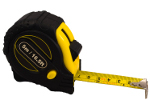Common Woodworking Tools
Author: steve Published Under: Home
 Tools
Toolsare one of the most expensive aspects of woodworking, but having the right tool and a well made tool makes all the difference. The type of tool required depends on the job, but there are a number of standard tools that are used in woodworking.
Marking the Wood
Before cutting, it is important to mark where you intend to cut. No matter how steady the hand, cutting by eye can be very difficult. Usually a pencil or a knife is used to mark the wood.
- Knives offer the advantage of being much more accurate than a pencil, while also actually cutting the wood slightly, which helps prepare it for the saw.
- Pencils, on the other hand, are great for storing information, such as which side is the face or to show how joints should fit together.
- Instead of a knife, it is also possible to use a H-Pencil,, like those used in school, but it is important that the pencil is very sharp.
Even if you use a pencil, tt is still a good idea to go back over it with a knife before cutting.
Measuring the Wood
The most common motto when it comes to woodworking is to "Measure twice, cut once." This can save you a great deal of headache and a great deal of wood, so is very important.
There are several tools used to measure wood.
- Measuring Tape: The measuring tape is the most common type of measuring tool. It is usually retractable and made out of thin metal. The quality of the tape measure, determines how accurate and precise the measurements are. There are also a number of specialty tapes available for use by certain professionals, such as a cabinet makers tape measure, which makes it easier to halve distances. A hook is also important, which is on the end of the measuring tape and holds it in place. Make sure that the distance taken up by the hook is accounted for on the measuring tape, otherwise your measurements will always be a little off.
- Steel Rules: When working with smaller pieces of wood, a steel rule will be more accurate and easier to use than a tape measure. They can also make it easier to determine how flat a piece of wood is.
- Combination Squares: Combination squares are incredibly useful and have many applications in woodworking. They can be used to draw right angles, as well as other angles, straight lines, gauge depth, or simply as a ruler. It can take awhile to master the many uses of the combination square, but it is an incredibly powerful.
- Folding Rules: Folding rules had originally been made of wood, but plastic and metal ones are now common. They offer the advantages of a steel rule, but can be folded up so they take up less space. You can also fold the sections in a right angle and use one end as a handle, to measure horizontal objects that are in the air.
- Sliding Bevel: A sliding Bevel is used to create a specific angle. It is adjusted using several knobs, which affect the angle. When using a sliding bevel, it is important to not push too heavily on its blade or jar it, as this can cause the angle to change.
A Closer Look at Knives
Knives are important tools not just for marking wood, but also for trimming it and changing it. There are three basic types of knives; marking knives, craft knives, and trimming knives.
- Marking Knives: These knives usually have a flat wooden handle, but the most important aspect is that the blade is only beveled on one side. When marking wood, the side without the bevel is placed against the square or ruler, so a straight accurate mark is made.
- Craft Knives: Craft knives are incredibly sharp and used to cut materials like veneer, plastic, paper, and card. Craft knives can be used for marking, but since they are beveled on both sides, the extra bevel must be taken into account.
- Trimming Knives: Trimming knives are very strong, tough, and have a variety of blade types. They are used when it is necessary to slightly trim a piece of wood, but space is very limited.
Dividers and Calipers
Dividers have straight legs and look very similar to a compass. They are used for measuring width when making dovetail joints. They can also be handy for transferring the measurement of an object where using a tape measure or ruler is not practical.
Calipers are used similarly, but have bowed legs instead of straight legs. They are, however, usually used to measure the internal and external dimensions of turned work or circular objects.
Dovetail Gauge:
This is used to mark the angles needed to cut a dovetail joint. You can buy a dovetail joint or make one yourself by machining a thin piece of metal plate.
Levels
The spirit level uses small bubbles of air trapped in fluid, to show whether an object is level. They are not as commonly used in furniture making, but essential for building and many types of construction. Levels also come in all different sizes, from only a few inches long to over four feet long.